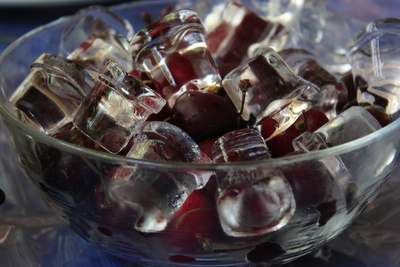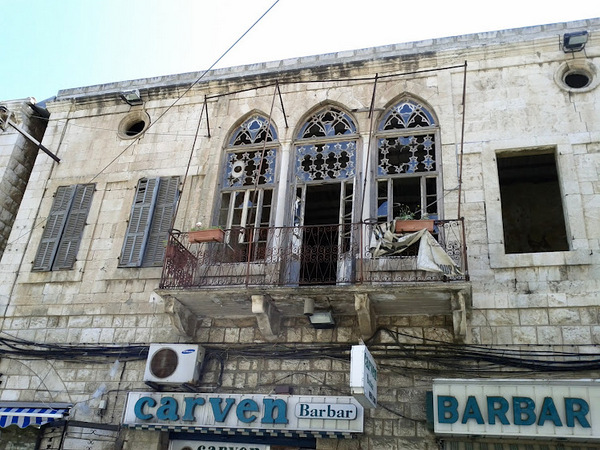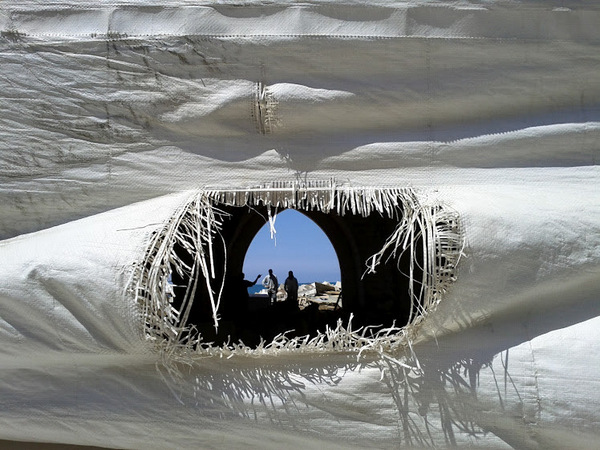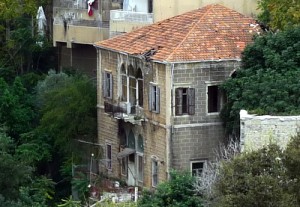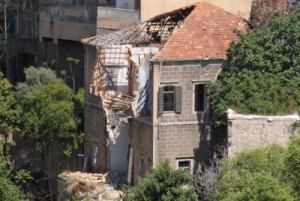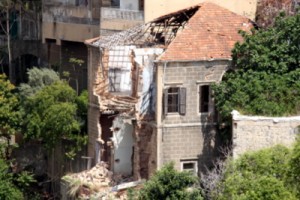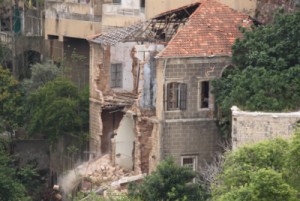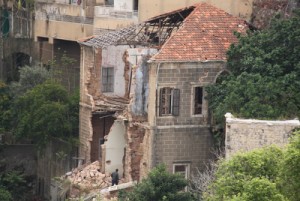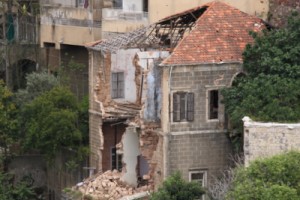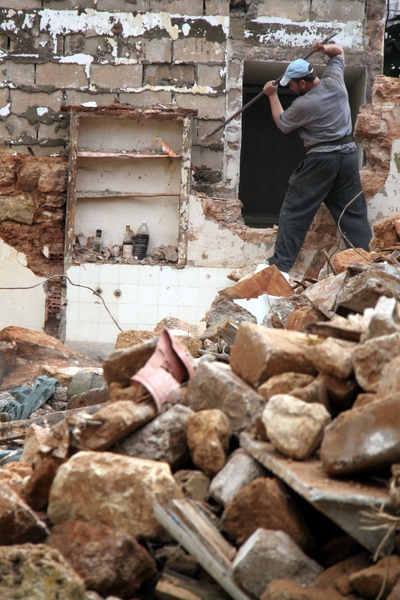- That huge tree which grows out of the ‘autostrade’ heading out of town, its roots pushing up the tarmac in the slow lane. Yes, the Lebanon has lost a lot of green and quite a few cedars, but this one old tree (a plane I think) is willing to take on the motorway. It’s so big you can actually see it on Google maps satellite view.
- How people are so enterprising and imaginative whatever their circumstances. I love that people display their goods on the roof of their car and that the parking attendant uses a plastic water bottle as a lampshade.
- Stairs. The narrow stairways linking winding streets, the stairways to nowhere, the outside stairways of three-storey family homes, the stairs that are no longer there.
- How people are so down-to-earth. It’s great to hear people say what they think.
- That people dress up. Am I being contradictory? I just love that the Lebanese dress up for events – even the down-to-earth ones.
- Wondering about the lives of houses which have been rent apart and exposed by rockets, by weeds and neglect, or by modern construction, so that the kitchen tiles now plaster the outside wall and the stairway is just a two-dimensional paint mark climbing the bricks.
- Fruits in season – any and all.
- The way people go out of their way for you – far, far out of their way.
- Being able to spend three quarters of the year outside – on the balcony, on terraces, in the mountains, by the sea, in the valleys…
- That people adore children. It still surprises me when 20-year old male waiters coming running over begging to hold my baby, and it’s always a bit weird when they walk off with her to introduce her to the rest of the staff, but it’s wonderful not to feel the weight of frowns all round when you enter a café.
Old town of Jounieh
Jounieh could be summarised as a collection of ill-assorted concrete shapes lining a motorway and littering a whole hillside. But in the old town of Jounieh, a lot of the lovely old buildings are being beautifully renovated.
And there’s a lot of work in progress.
Sky bar on a budget
I’m always fascinated by construction workers, up in these skyscrapers, miles above the rest of us.
Their nonchalance is striking. We pay to climb monuments for a lesser view. When I see the shacks they live in at the foot of these megalomanic projects, I’m glad they get to have lunch up there.
Now you see it…
Over the past year I have often gazed at a lone house on the slopes of Achrafieh. It is only a lone house by a matter of a few meters, but the tufts of green undergrowth separate it out from the background of concrete colour blocks of flats which flank it. And while bright laundry decorates the balconies of the flats, this house stands quiet and pensive, the door ajar, the window panes gone. Still, it is a perfect foursquare house just waiting for someone to clear out any winged squatters and smarten it up.
Some weeks ago I noticed some roof tiles had come away, exposing the rafters. I checked it anxiously after a stormy night, but nothing had changed. Then, a few sunny days later, there was a gaping hole in the roof. The hole spread a little down the façade day by day. On Tuesday I noticed some men inside through the glass-less windows. As I watched, some bricks were pushed off the first floor and tumbled down the hill. They must be checking out the damage, I thought, or perhaps trying to make it safe so nothing big falls on the neighbours.
On Wednesday they were there again. I could see them clearly because the holes in the façade were bigger. Only this time I watched for a while. They moved from room to room, hitting at the battered window frames and outer wall. With a pole one worked to dislodge large stones in the wall on the ground floor. With the support weakened he was then able to knock down more of the first floor wall.
By now it looked like so many of the property ruins hit by mortar shells or rockets during the war. Except it wasn’t. Every day since they have been back to accelerate the erosion of the house.
When a beautiful property in my neighbourhood was bulldozed and replaced by a strip of black tarmac (aka a carpark), I asked the neighbours about it. The storekeeper next door assured me it would be replaced by a new building but that the planning permission would take around five years. What about knocking the place down? I wanted to know. Did anyone get permission for that? The storekeeper was shocked. Of course the developer had had to get permission. One couldn’t get away with such a thing in town. Still, I’ve heard of such things happening.
So now I am wondering why these two men turn up every day, haphazardly knocking the support out from under this roof, then disappear, leaving gravity and the elements to make a difference overnight. Bulldozer access might be difficult, not to mention expensive. But even if the plan was to demolish the building by manpower rather than machines, surely they would come with some tools – a sledgehammer for example. Is the owner really just trying to save money? If you can’t fit machinery up the passageway for the demolition, how will they bring in the machinery necessary to build on the land when the rubble is cleared?
Perhaps someone out there knows this place in Mar Mikhael and has an answer.
Streets of Beirut XXXI
When the builders first arrived at a beautiful though dilapidated house nearby, they cleaned the debris from the triple arches in the façade, and for a while I wondered if the new owner planned to restore the property. A few days later a heap of rubble replaced the building, quashing this unrealistic hope. The bulldozer sits on high and the irreverent builders swarm over the stones.
Against a wall shared with an adjacent building, the kitchen tiling still clings, along with a cupboard with the front ripped off, exposing bottles of cooking oil and vinegar from decades past.
I was tickled to see that this one lonely cupboard gave the builders quite some trouble. They all had a go at removing it and still hadn’t succeeded by the time I moved on.
